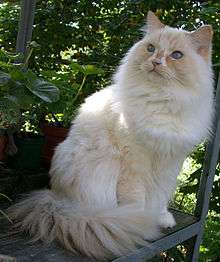Ragamuffin cat
| Ragamuffin | |
|---|---|
 | |
| Origin | United States |
| Breed standards | |
| CFA | standard |
| ACFA/CAA | standard |
| Domestic cat (Felis catus) | |
The Ragamuffin is a breed of domestic cat. It is a variant of the Ragdoll cat and was established as a separate breed in 1994. Ragamuffins are notable for their friendly personalities and thick, rabbitlike fur.
General description
Ragamuffins are a muscular, heavy breed of cat needing approximately four to five years to fully mature.[1] The physical traits of the breed include a rectangular, broad-chested body with shoulders supporting a short neck. These cats are classified as having a "substantial" body type.[2] Ragamuffins come in all coat colors and patterns, with a medium-length coat that increases in length toward the stomach. Although the coat is thick and plush, it does not readily mat or clump and is easy to care for.
The head is a broad, modified wedge with a moderately rounded forehead and a nose dip. The body should appear rectangular with a broad chest and broad shoulders and moderately heavy muscling in the hindquarters, with the hindquarters being equally broad as the shoulders. There should be a fatty pad in the lower abdomen. Fur length is to be slightly longer around the neck and outer edges of the face, resulting in the appearance of a ruff. The fur should increase in length from the top of the head down through the shoulder blades and back, with the coat on the sides and stomach being medium to medium long. Every color and pattern is allowable, with or without white. Some color patterns, such as pure white, are rarer than others and are generally in greater demand.
History
The Ragamuffin is a crossbreed of the Ragdoll with various other breeds, mostly Persian and its offshoot, Himalayan.
Ragdoll background
In the 1960s, a regular, non-pedigreed, light-grey, domestic long-haired cat named Josephine (of unknown Angora or Persian stock), who had produced several litters of typical kittens, eventually produced a litter of unusually docile kittens. When the subsequent litter produced more of the same, Ann Baker (an established cat breeder) purchased several kittens from the owner and set out to create what is now known as the Ragdoll. The sires were of unrecorded Birman or Burmese ancestry.
In the mid 1970s, after many of the original Ragdoll breeders left, Baker decided to spurn traditional cat breeding associations. She trademarked the name "Ragdoll", and set up her own registry, International Ragdoll Cat Association (IRCA). Baker imposed stringent standards on anyone who wanted to breed or sell cats under that name. The IRCA Ragdolls were also not allowed to be registered in other breed associations.
Breed divergence
In 1994, a group of IRCA breeders decided to leave and form their own group because of the increasing restrictions. Owing to Baker's trademark on the name Ragdoll, the group renamed its stock of IRCA Ragdoll cats Ragamuffins. While the originally proposed name was Liebling, the name Ragamuffin was put forth as an alternative by one of the group's founders and it was chosen.
In the spirit of bettering the breed's genetic health, personality, and temperament, the group out-crossed to Persians, Himalayans, and non-pedigreed domestic long-haired cats. The group also allowed some out-crossing to original Ragdolls (which ended in 2010 for ACFA-recognized Ragamuffins). Only cats with at least one Ragamuffin parent and an ACFA-accepted out-cross currently qualify to be called ACFA Ragamuffins. Cat Fanciers' Association Ragamuffins may only have Ragamuffin parents.
The first cat association to accept the breed at full show champion status was the United Feline Organization (UFO), and while some major cat associations still refuse to accept the Ragamuffin as a recognized breed (primarily because of its close association with the Ragdoll), it was accepted into the American Cat Fanciers Association (ACFA). Finally, the Cat Fanciers' Association (CFA) accepted them into the Miscellaneous class in February, 2003 and advanced them to Championship class in February, 2011.
The most obvious difference between typical Ragdolls and Ragamuffins is the lack of point coloration in the latter, a trait that was bred out, while remaining desirable in the earlier breed.
Color forms
Ragamuffins come in all patterns and colors, although colorpoints are not allowed under CFA standards.[3] Their eyes can be any solid color, with some exhibiting heterochromia.
References
- ↑ "Ragamuffin - Cat breeds, pictures & Info". Felinexpress.com. 2007-11-17. Retrieved 2014-08-06.
- ↑ Stephens, Gloria. Legacy of the cat. Chronicle books, 2001.
- ↑ Breed Standard: Ragamuffin Cat Fanciers Association Archived 2005-12-08 at the Wayback Machine.
External links
| Wikimedia Commons has media related to Ragamuffin. |
| Look up Ragamuffin in Wiktionary, the free dictionary. |
- Ragdolls (floppy cats) information
- RagaMuffin Associated Group The original breed club begun by those who founded the Ragamuffin breed
- The RagaMuffin Kitten Breeders Society A group of RagaMuffin breeders and Ragamuffin lovers dedicated to raising authentic Ragamuffins while adhering to a code of ethics with respect to best breeding practices.
- Breed profile at IAMS cat breed guide
- CFA Ragamuffin Breed Profile
- Catster Ragamuffin Article